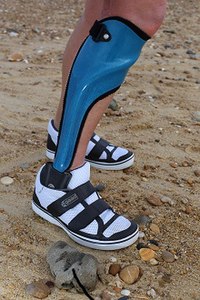
Photo from wikipedia
Introduction/Background Upright bipedalism is one of the distinctive features that differentiates humans from quadrupedal mammals. Imaging studies using single photon emission computed tomography and functional near infrared spectroscopy have demonstrated… Click to show full abstract
Introduction/Background Upright bipedalism is one of the distinctive features that differentiates humans from quadrupedal mammals. Imaging studies using single photon emission computed tomography and functional near infrared spectroscopy have demonstrated that, in the frontal lobe, the primary sensorimotor area and the supplementary motor area were activated during walking. To understand cortical mechanisms related to truncal posture control during human locomotion, we investigated hemodynamic responses in the supplementary motor area with and without trunk orthosis. If the supplementary motor area is related to truncal control, we assume that the activation of supplemental motor area would decrease during gait with trunk orthosis because human need less control for truncal posture. Material and method Twelve healthy human adults participated in this study. All participants provided their written informed consent prior to the study. We used functional near infrared spectroscopy to measure the activity of supplementary motor area while participants walked on a treadmill. All participants walked in two conditions: walk independently and walk wearing trunk orthosis. In each condition, task comprised five repetitions of walking for 40 s each followed by 40 s of rest as a block. We used oxy-Hb concentrations rather than deoxy-Hb concentrations because the former are reportedly related to brain activity. Results Compared with the baseline, the oxy-Hb level increased from the beginning of the trial but subsequently decreased and remained below the baseline before a trough in the rest phase. The peak value of the independent condition was higher than that of the trunk orthosis condition. Conclusion From our results, the supplementary motor area is related to truncal control during walking.
Journal Title: Annals of Physical and Rehabilitation Medicine
Year Published: 2018
Link to full text (if available)
Share on Social Media: Sign Up to like & get
recommendations!